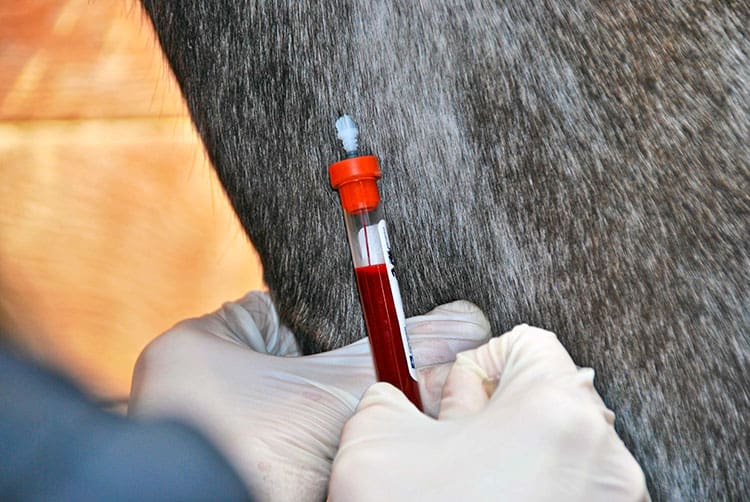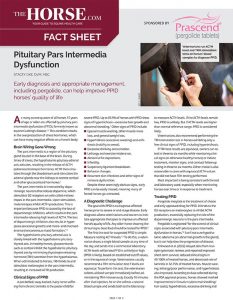Testing Horses for PPID: Challenges of Interpretation

Pituitary pars intermedia dysfunction (PPID) is a common endocrine disease of older horses, affecting approximately 20-30% of this population, though veterinarians also see it in younger horses. The disease affects part of the pituitary gland called the pars intermedia, causing the gland to grow and secrete increased levels of hormones such as adrenocorticotropin (ACTH). Common clinical signs include loss of topline or muscle mass, delayed or absent shedding, and a long hair coat, known as hypertrichosis. This long hair coat might occur in patches or over the entire body. Affected horses might also develop the hoof disease laminitis.
Veterinarians often base their diagnosis of PPID on clinical signs, particularly in cases of advanced disease. However, in horses with early or equivocal clinical signs, tests can help determine PPID status.
Diagnostic Testing

Tests for PPID involve measuring resting levels of ACTH using a single sample blood test or evaluating ACTH response to thyrotropin-releasing hormone (TRH) stimulation. The dexamethasone suppression test is another diagnostic test for PPID, but veterinarians rarely use it. In the TRH stimulation test, veterinarians collect blood for ACTH measurement before and 10 minutes after administering a standard dose of TRH intravenously. Because the TRH stimulation test gauges hormone level response to a stimulus (i.e., it’s a dynamic test), during most of the year it is generally more sensitive for identifying PPID than other tests. In horses with laminitis veterinarians should also evaluate insulin levels and/or the horse’s insulin response to an oral sugar test, because laminitis is strongly associated with abnormal insulin regulation.
Factors Influencing Test Results
Many factors besides PPID status can influence adrenocorticotropin levels, including breed, thriftiness, management (e.g., whether the horse’s diet includes grain), concurrent stress or disease, geographic location, laboratory method, sample handling and storage, and, most importantly, time of year. So, the most crucial factor to consider when interpreting diagnostic tests is season.
The pituitary gland releases adrenocorticotropin seasonally; hormone levels start to rise in summer, peak in fall, and are at their lowest in late spring. This means horses—even those without PPID—have higher ACTH and ACTH responses to TRH during the fall, making test results difficult to interpret. Researchers have established reference ranges for the fall, transition seasons (from summer to fall and fall to winter), and nonfall (winter, spring, summer). In horses with PPID the rise in ACTH (and TRH response to ACTH) during the fall is more marked than that in horses without PPID. But because horses without PPID can have more variable ACTH responses to TRH in the fall than in other seasons, it’s challenging to establish fall reference ranges for this test. I recommend using resting ACTH concentrations in the fall and response to TRH stimulation in all other seasons to diagnose PPID.
In addition to using seasonally appropriate reference ranges to interpret results, it is important to control for other factors, when possible. Withhold grain prior to and during testing. Ideally, testing should be done on the farm to eliminate the stress of hospitalization. Your horse should be free of other disease when testing is performed. Veterinarians must keep blood samples chilled and ensure they’re centrifuged within three hours. Whenever possible, the reference ranges used should account for geographic location (e.g., the Northern vs. Southern hemispheres). Being consistent with laboratory method is also important, because different methods of measurement (or different laboratories, even if they are using the same methodology) can reach very different results.
Conclusion
Pituitary pars intermedia dysfunction remains a difficult disease to diagnose, in part because there is no “gold standard” test. Because of the challenge of interpreting diagnostic tests, these should not be performed in the absence of clinical signs. Season can influence your veterinarian’s diagnostic test of choice (TRH stimulation or resting ACTH). A variety of factors can influence reference ranges and are an ongoing area of research. Your veterinarian can help you decide if and when to test your horse and will interpret test results in the context of your horse’s clinical signs.
Written by:
Heidi Banse, DVM, MS, Dipl. ACVIM
Related Articles
Stay on top of the most recent Horse Health news with












